BMW M6 CONVERTIBLE 2015 F12M Owner's Manual
Manufacturer: BMW, Model Year: 2015, Model line: M6 CONVERTIBLE, Model: BMW M6 CONVERTIBLE 2015 F12MPages: 230, PDF Size: 4.9 MB
Page 141 of 230
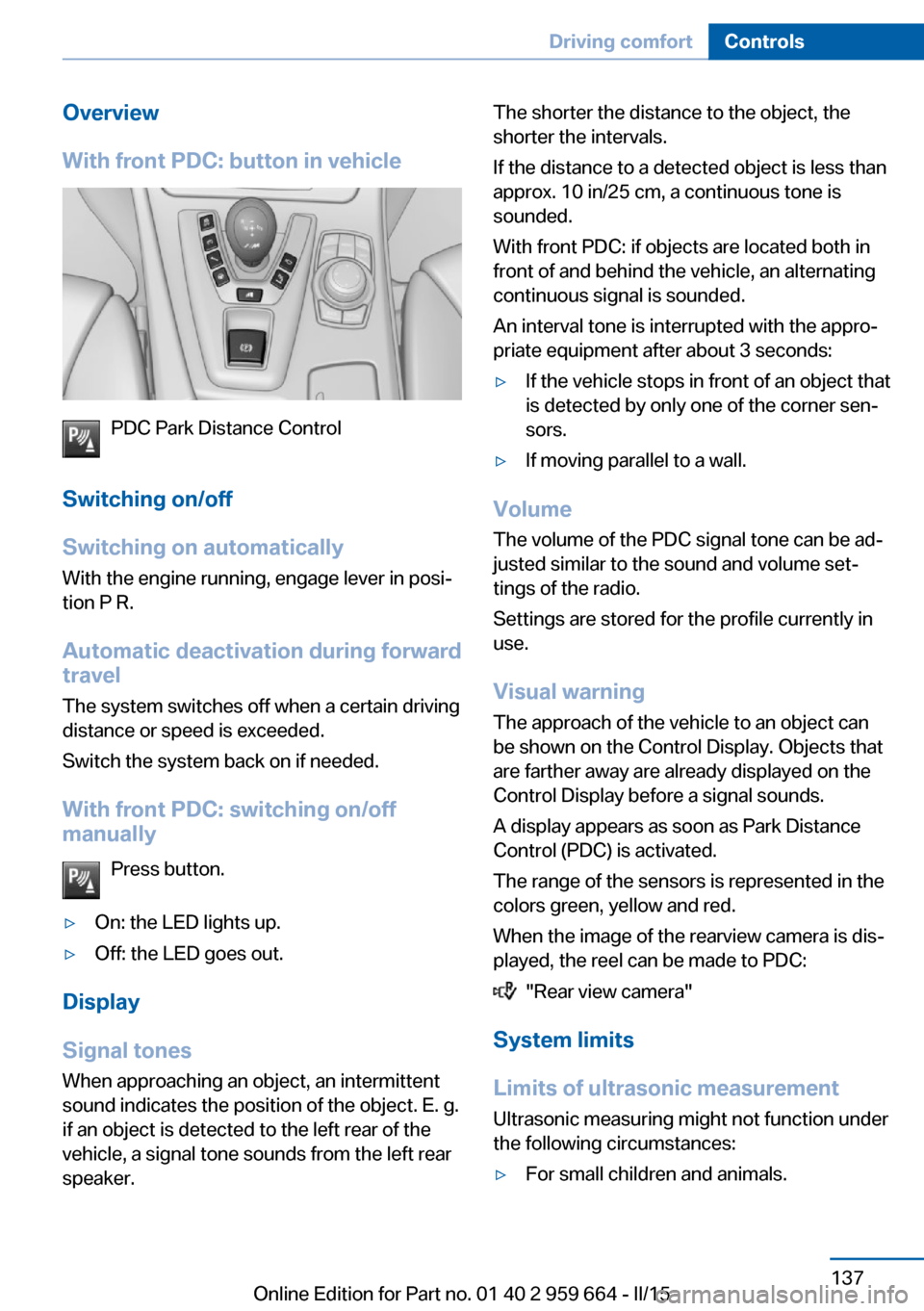
Overview
With front PDC: button in vehicle
PDC Park Distance Control
Switching on/off
Switching on automatically With the engine running, engage lever in posiŌĆÉ
tion P R.
Automatic deactivation during forward
travel
The system switches off when a certain driving
distance or speed is exceeded.
Switch the system back on if needed.
With front PDC: switching on/off
manually
Press button.
Ō¢ĘOn: the LED lights up.Ō¢ĘOff: the LED goes out.
Display
Signal tones When approaching an object, an intermittent
sound indicates the position of the object. E. g.
if an object is detected to the left rear of the
vehicle, a signal tone sounds from the left rear
speaker.
The shorter the distance to the object, the
shorter the intervals.
If the distance to a detected object is less than
approx. 10 in/25 cm, a continuous tone is
sounded.
With front PDC: if objects are located both in
front of and behind the vehicle, an alternating
continuous signal is sounded.
An interval tone is interrupted with the approŌĆÉ
priate equipment after about 3 seconds:Ō¢ĘIf the vehicle stops in front of an object that
is detected by only one of the corner senŌĆÉ
sors.Ō¢ĘIf moving parallel to a wall.
Volume
The volume of the PDC signal tone can be adŌĆÉ
justed similar to the sound and volume setŌĆÉ
tings of the radio.
Settings are stored for the profile currently in
use.
Visual warning
The approach of the vehicle to an object can
be shown on the Control Display. Objects that
are farther away are already displayed on the
Control Display before a signal sounds.
A display appears as soon as Park Distance
Control (PDC) is activated.
The range of the sensors is represented in the
colors green, yellow and red.
When the image of the rearview camera is disŌĆÉ
played, the reel can be made to PDC:
"Rear view camera"
System limits
Limits of ultrasonic measurement
Ultrasonic measuring might not function under
the following circumstances:
Ō¢ĘFor small children and animals.Seite 137Driving comfortControls137
Online Edition for Part no. 01 40 2 959 664 - II/15
Page 142 of 230
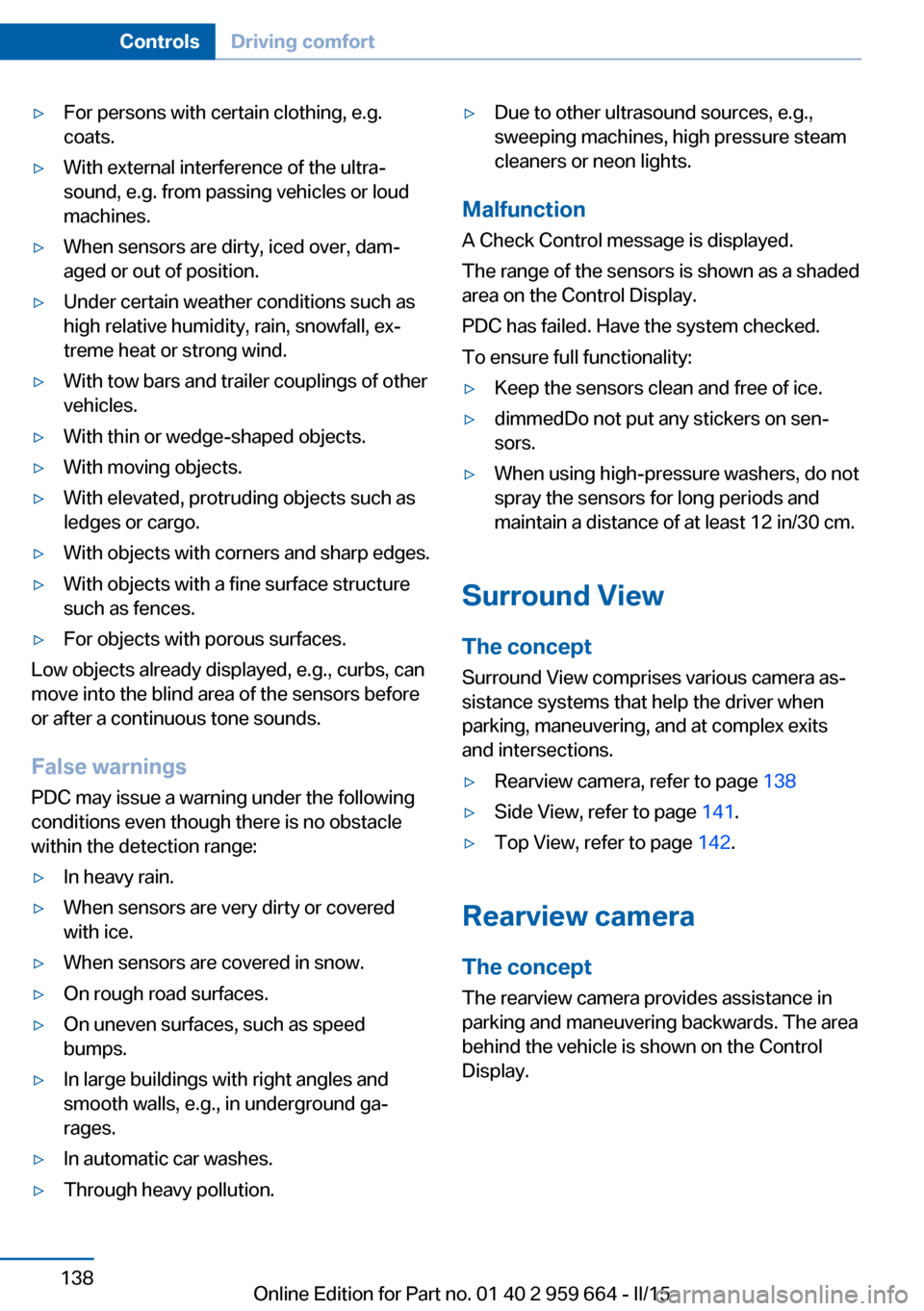
Ō¢ĘFor persons with certain clothing, e.g.
coats.Ō¢ĘWith external interference of the ultraŌĆÉ
sound, e.g. from passing vehicles or loud
machines.Ō¢ĘWhen sensors are dirty, iced over, damŌĆÉ
aged or out of position.Ō¢ĘUnder certain weather conditions such as
high relative humidity, rain, snowfall, exŌĆÉ
treme heat or strong wind.Ō¢ĘWith tow bars and trailer couplings of other
vehicles.Ō¢ĘWith thin or wedge-shaped objects.Ō¢ĘWith moving objects.Ō¢ĘWith elevated, protruding objects such as
ledges or cargo.Ō¢ĘWith objects with corners and sharp edges.Ō¢ĘWith objects with a fine surface structure
such as fences.Ō¢ĘFor objects with porous surfaces.
Low objects already displayed, e.g., curbs, can
move into the blind area of the sensors before
or after a continuous tone sounds.
False warnings
PDC may issue a warning under the following conditions even though there is no obstacle
within the detection range:
Ō¢ĘIn heavy rain.Ō¢ĘWhen sensors are very dirty or covered
with ice.Ō¢ĘWhen sensors are covered in snow.Ō¢ĘOn rough road surfaces.Ō¢ĘOn uneven surfaces, such as speed
bumps.Ō¢ĘIn large buildings with right angles and
smooth walls, e.g., in underground gaŌĆÉ
rages.Ō¢ĘIn automatic car washes.Ō¢ĘThrough heavy pollution.Ō¢ĘDue to other ultrasound sources, e.g.,
sweeping machines, high pressure steam
cleaners or neon lights.
Malfunction
A Check Control message is displayed.
The range of the sensors is shown as a shaded
area on the Control Display.
PDC has failed. Have the system checked.
To ensure full functionality:
Ō¢ĘKeep the sensors clean and free of ice.Ō¢ĘdimmedDo not put any stickers on senŌĆÉ
sors.Ō¢ĘWhen using high-pressure washers, do not
spray the sensors for long periods and
maintain a distance of at least 12 in/30 cm.
Surround View
The concept Surround View comprises various camera asŌĆÉ
sistance systems that help the driver when
parking, maneuvering, and at complex exits
and intersections.
Ō¢ĘRearview camera, refer to page 138Ō¢ĘSide View, refer to page 141.Ō¢ĘTop View, refer to page 142.
Rearview camera
The concept The rearview camera provides assistance in
parking and maneuvering backwards. The area
behind the vehicle is shown on the Control
Display.
Seite 138ControlsDriving comfort138
Online Edition for Part no. 01 40 2 959 664 - II/15
Page 143 of 230
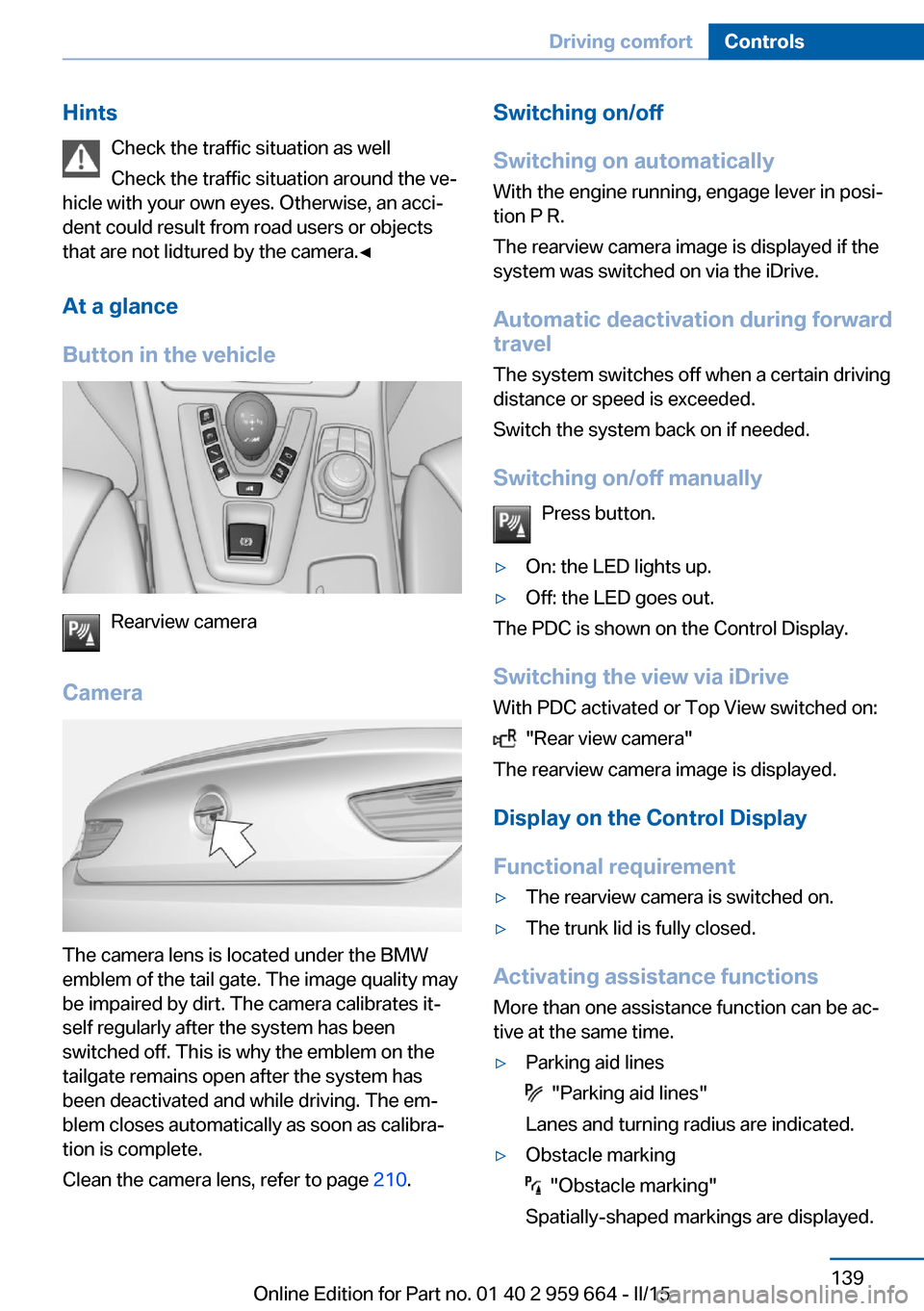
HintsCheck the traffic situation as well
Check the traffic situation around the veŌĆÉ
hicle with your own eyes. Otherwise, an acciŌĆÉ
dent could result from road users or objects
that are not lidtured by the camera.ŌŚĆ
At a glance
Button in the vehicle
Rearview camera
Camera
The camera lens is located under the BMW
emblem of the tail gate. The image quality may
be impaired by dirt. The camera calibrates itŌĆÉ
self regularly after the system has been
switched off. This is why the emblem on the
tailgate remains open after the system has
been deactivated and while driving. The emŌĆÉ
blem closes automatically as soon as calibraŌĆÉ
tion is complete.
Clean the camera lens, refer to page 210.
Switching on/off
Switching on automatically With the engine running, engage lever in posiŌĆÉ
tion P R.
The rearview camera image is displayed if the
system was switched on via the iDrive.
Automatic deactivation during forward
travel
The system switches off when a certain driving
distance or speed is exceeded.
Switch the system back on if needed.
Switching on/off manually Press button.Ō¢ĘOn: the LED lights up.Ō¢ĘOff: the LED goes out.
The PDC is shown on the Control Display.
Switching the view via iDrive With PDC activated or Top View switched on:
"Rear view camera"
The rearview camera image is displayed.
Display on the Control Display
Functional requirement
Ō¢ĘThe rearview camera is switched on.Ō¢ĘThe trunk lid is fully closed.
Activating assistance functions
More than one assistance function can be acŌĆÉ
tive at the same time.
Ō¢ĘParking aid lines
"Parking aid lines"
Lanes and turning radius are indicated.
Ō¢ĘObstacle marking
"Obstacle marking"
Spatially-shaped markings are displayed.
Seite 139Driving comfortControls139
Online Edition for Part no. 01 40 2 959 664 - II/15
Page 144 of 230
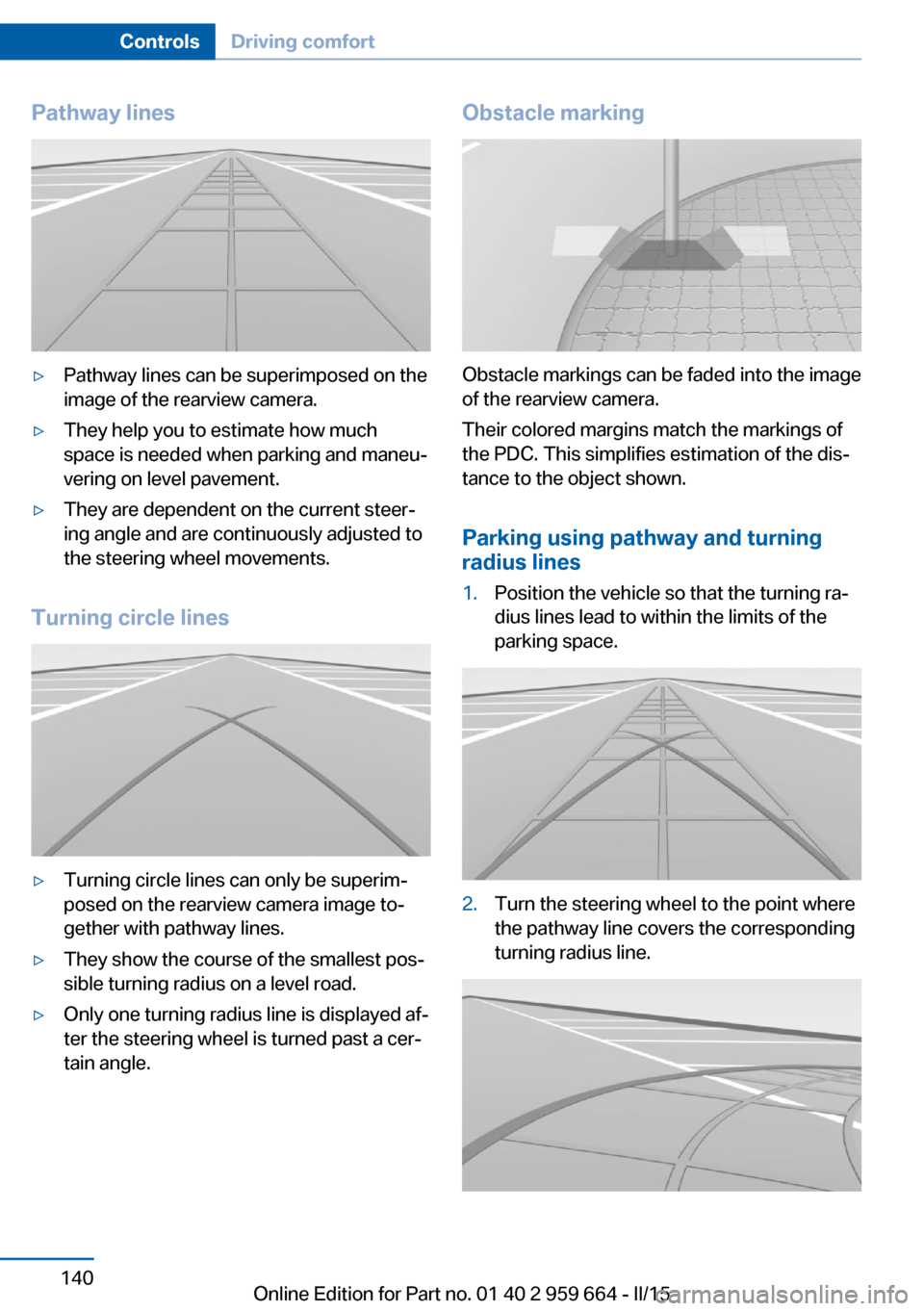
Pathway linesŌ¢ĘPathway lines can be superimposed on the
image of the rearview camera.Ō¢ĘThey help you to estimate how much
space is needed when parking and maneuŌĆÉ
vering on level pavement.Ō¢ĘThey are dependent on the current steerŌĆÉ
ing angle and are continuously adjusted to
the steering wheel movements.
Turning circle lines
Ō¢ĘTurning circle lines can only be superimŌĆÉ
posed on the rearview camera image toŌĆÉ
gether with pathway lines.Ō¢ĘThey show the course of the smallest posŌĆÉ
sible turning radius on a level road.Ō¢ĘOnly one turning radius line is displayed afŌĆÉ
ter the steering wheel is turned past a cerŌĆÉ
tain angle.Obstacle marking
Obstacle markings can be faded into the image
of the rearview camera.
Their colored margins match the markings of
the PDC. This simplifies estimation of the disŌĆÉ
tance to the object shown.
Parking using pathway and turning
radius lines
1.Position the vehicle so that the turning raŌĆÉ
dius lines lead to within the limits of the
parking space.2.Turn the steering wheel to the point where
the pathway line covers the corresponding
turning radius line.Seite 140ControlsDriving comfort140
Online Edition for Part no. 01 40 2 959 664 - II/15
Page 145 of 230
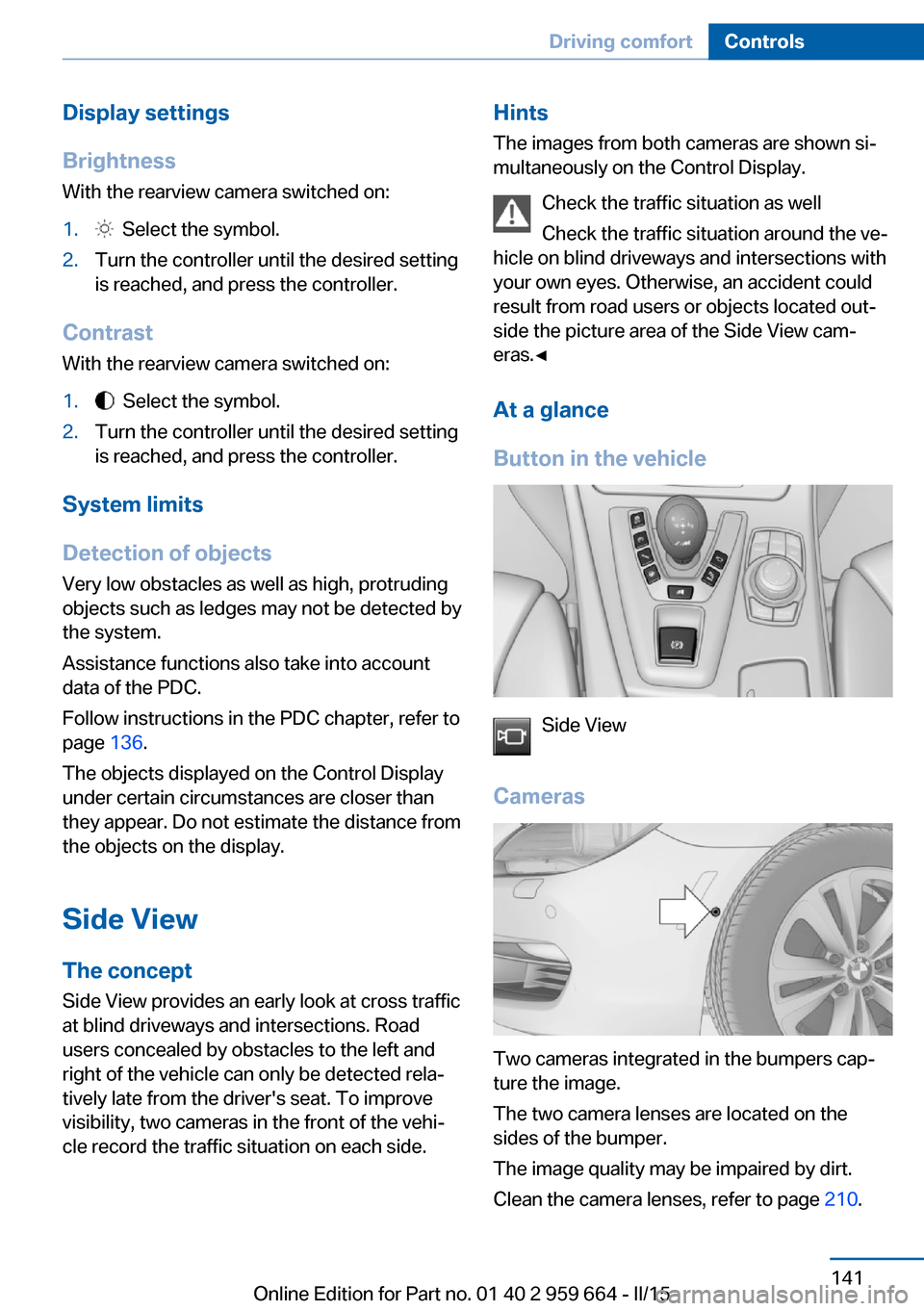
Display settings
Brightness
With the rearview camera switched on:1. Select the symbol.2.Turn the controller until the desired setting
is reached, and press the controller.
Contrast
With the rearview camera switched on:
1. Select the symbol.2.Turn the controller until the desired setting
is reached, and press the controller.
System limits
Detection of objects
Very low obstacles as well as high, protruding
objects such as ledges may not be detected by
the system.
Assistance functions also take into account
data of the PDC.
Follow instructions in the PDC chapter, refer to
page 136.
The objects displayed on the Control Display
under certain circumstances are closer than
they appear. Do not estimate the distance from
the objects on the display.
Side View The concept Side View provides an early look at cross traffic
at blind driveways and intersections. Road
users concealed by obstacles to the left and
right of the vehicle can only be detected relaŌĆÉ
tively late from the driver's seat. To improve
visibility, two cameras in the front of the vehiŌĆÉ
cle record the traffic situation on each side.
Hints
The images from both cameras are shown siŌĆÉ
multaneously on the Control Display.
Check the traffic situation as well
Check the traffic situation around the veŌĆÉ
hicle on blind driveways and intersections with
your own eyes. Otherwise, an accident could
result from road users or objects located outŌĆÉ
side the picture area of the Side View camŌĆÉ
eras.ŌŚĆ
At a glance
Button in the vehicle
Side View
Cameras
Two cameras integrated in the bumpers capŌĆÉ
ture the image.
The two camera lenses are located on the
sides of the bumper.
The image quality may be impaired by dirt.
Clean the camera lenses, refer to page 210.
Seite 141Driving comfortControls141
Online Edition for Part no. 01 40 2 959 664 - II/15
Page 146 of 230

Switching on/off
Switching on/off manually Press button.
Automatic deactivation during forward
travel
The system switches off when a certain driving
distance or speed is exceeded.
Switch the system back on if needed.
Display
The traffic area to the left and right is displayed
on the Control Display.
Guidelines at the bottom of the image show
the position of the front of the vehicle.
Brightness With the Side View switched on:
1. "Brightness"2.Turn the controller until the desired setting
is reached, and press the controller.
Contrast
With the Side View switched on:
1. "Contrast"2.Turn the controller until the desired setting
is reached, and press the controller.System limits
The cameras lidture a maximum range of
330 ft/100 m.
Top View
The concept Top View provides assistance in parking and
maneuvering. The area around the doors and
the road area around the vehicle are shown on
the Control Display for this purpose.
General information
The image is lidtured by two cameras
integrated in the exterior mirrors and by the
rearview camera.
The range is at least 7 ft/2 m to the side and
rear.
In this way, obstacles up to the height of the
exterior mirrors are detected early.
Hints Check the traffic situation as well
Check the traffic situation around the veŌĆÉ
hicle with your own eyes. Otherwise, an acciŌĆÉ
dent could result from road users or objects
that are not lidtured by the camera.ŌŚĆ
Overview
Button in the vehicle
Top View
Seite 142ControlsDriving comfort142
Online Edition for Part no. 01 40 2 959 664 - II/15
Page 147 of 230
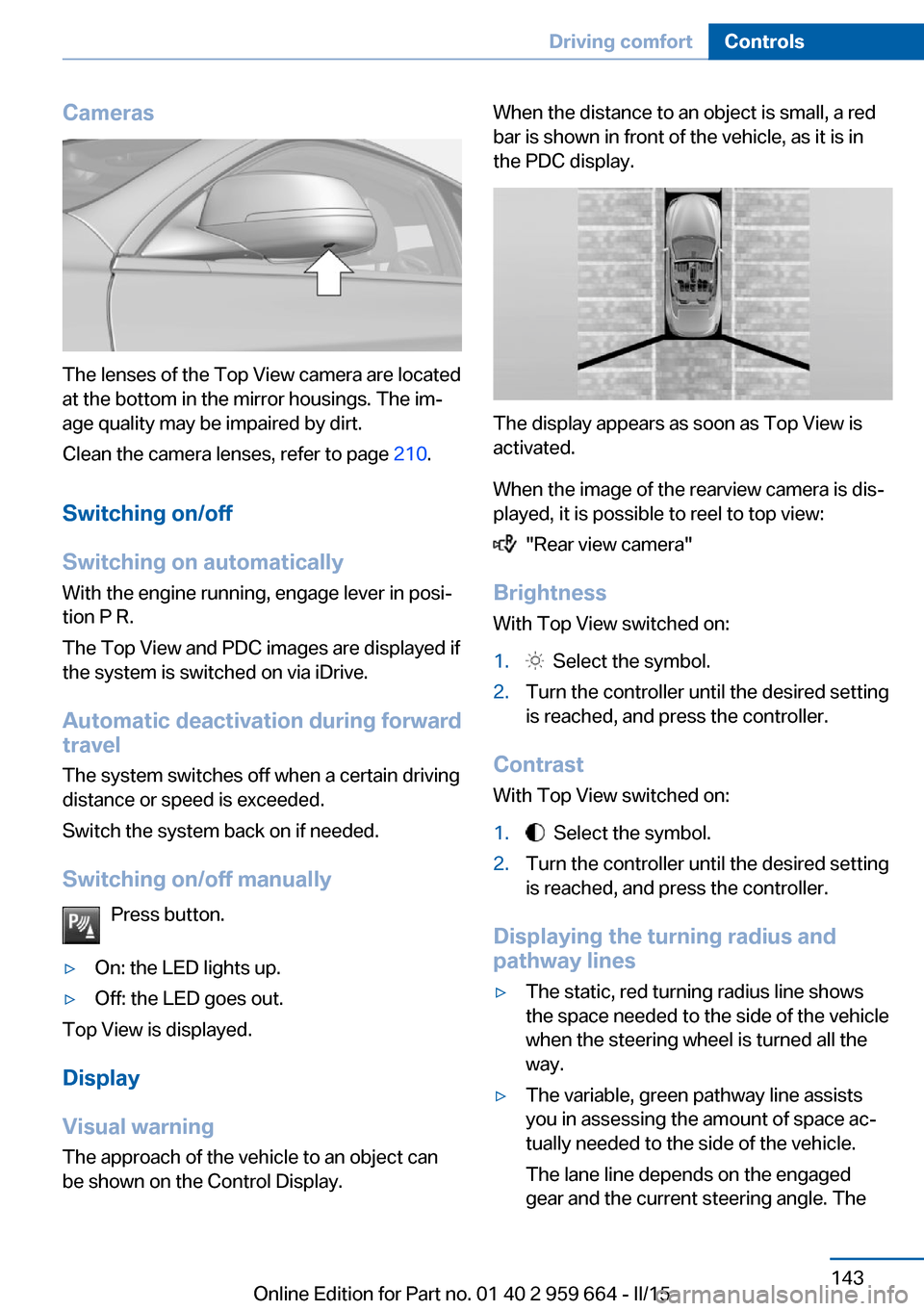
Cameras
The lenses of the Top View camera are located
at the bottom in the mirror housings. The imŌĆÉ
age quality may be impaired by dirt.
Clean the camera lenses, refer to page 210.
Switching on/off
Switching on automatically With the engine running, engage lever in posiŌĆÉ
tion P R.
The Top View and PDC images are displayed if
the system is switched on via iDrive.
Automatic deactivation during forward
travel
The system switches off when a certain driving
distance or speed is exceeded.
Switch the system back on if needed.
Switching on/off manually Press button.
Ō¢ĘOn: the LED lights up.Ō¢ĘOff: the LED goes out.
Top View is displayed.
Display
Visual warning
The approach of the vehicle to an object can
be shown on the Control Display.
When the distance to an object is small, a red
bar is shown in front of the vehicle, as it is in
the PDC display.
The display appears as soon as Top View is
activated.
When the image of the rearview camera is disŌĆÉ
played, it is possible to reel to top view:
"Rear view camera"
Brightness
With Top View switched on:
1. Select the symbol.2.Turn the controller until the desired setting
is reached, and press the controller.
Contrast
With Top View switched on:
1. Select the symbol.2.Turn the controller until the desired setting
is reached, and press the controller.
Displaying the turning radius and
pathway lines
Ō¢ĘThe static, red turning radius line shows
the space needed to the side of the vehicle
when the steering wheel is turned all the
way.Ō¢ĘThe variable, green pathway line assists
you in assessing the amount of space acŌĆÉ
tually needed to the side of the vehicle.
The lane line depends on the engaged
gear and the current steering angle. TheSeite 143Driving comfortControls143
Online Edition for Part no. 01 40 2 959 664 - II/15
Page 148 of 230
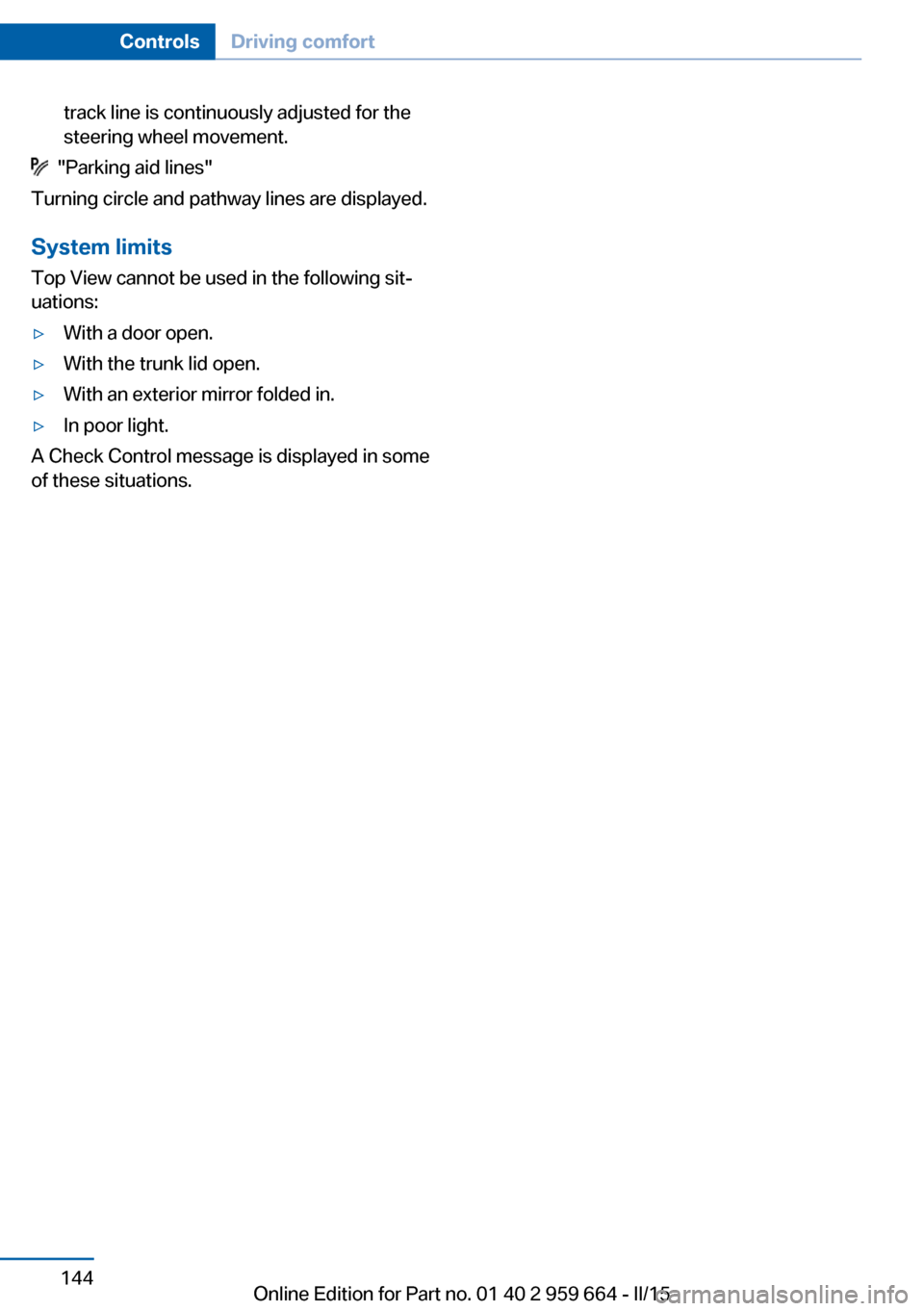
track line is continuously adjusted for the
steering wheel movement.
"Parking aid lines"
Turning circle and pathway lines are displayed.
System limits
Top View cannot be used in the following sitŌĆÉ
uations:
Ō¢ĘWith a door open.Ō¢ĘWith the trunk lid open.Ō¢ĘWith an exterior mirror folded in.Ō¢ĘIn poor light.
A Check Control message is displayed in some
of these situations.
Seite 144ControlsDriving comfort144
Online Edition for Part no. 01 40 2 959 664 - II/15
Page 149 of 230

Climate controlVehicle features and options
This chapter describes all standard, country-
specific and optional features offered with the
series. It also describes features that are not
necessarily available in your car, e. g., due tothe selected options or country versions. This
also applies to safety-related functions and
systems. The respectively applicable country
provisions must be observed when using the
respective features and systems.
Automatic climate control
1Air distribution, left2Temperature, left3AUTO program, left4Air flow, AUTO intensity, left, residual heat5Remove ice and condensation6Maximum cooling7Display8Air flow, AUTO intensity, right9AUTO program, right10Temperature, right11Air distribution, right12Seat heating, rightŌĆéŌĆģ 5813Active seat ventilation, rightŌĆéŌĆģ 5814Automatic recirculated-air control/recircuŌĆÉ
lated-air mode15Cooling function16Rear window defroster17SYNC program18Active seat ventilation, leftŌĆéŌĆģ 5819Seat heating, leftŌĆéŌĆģ58Seite 145Climate controlControls145
Online Edition for Part no. 01 40 2 959 664 - II/15
Page 150 of 230
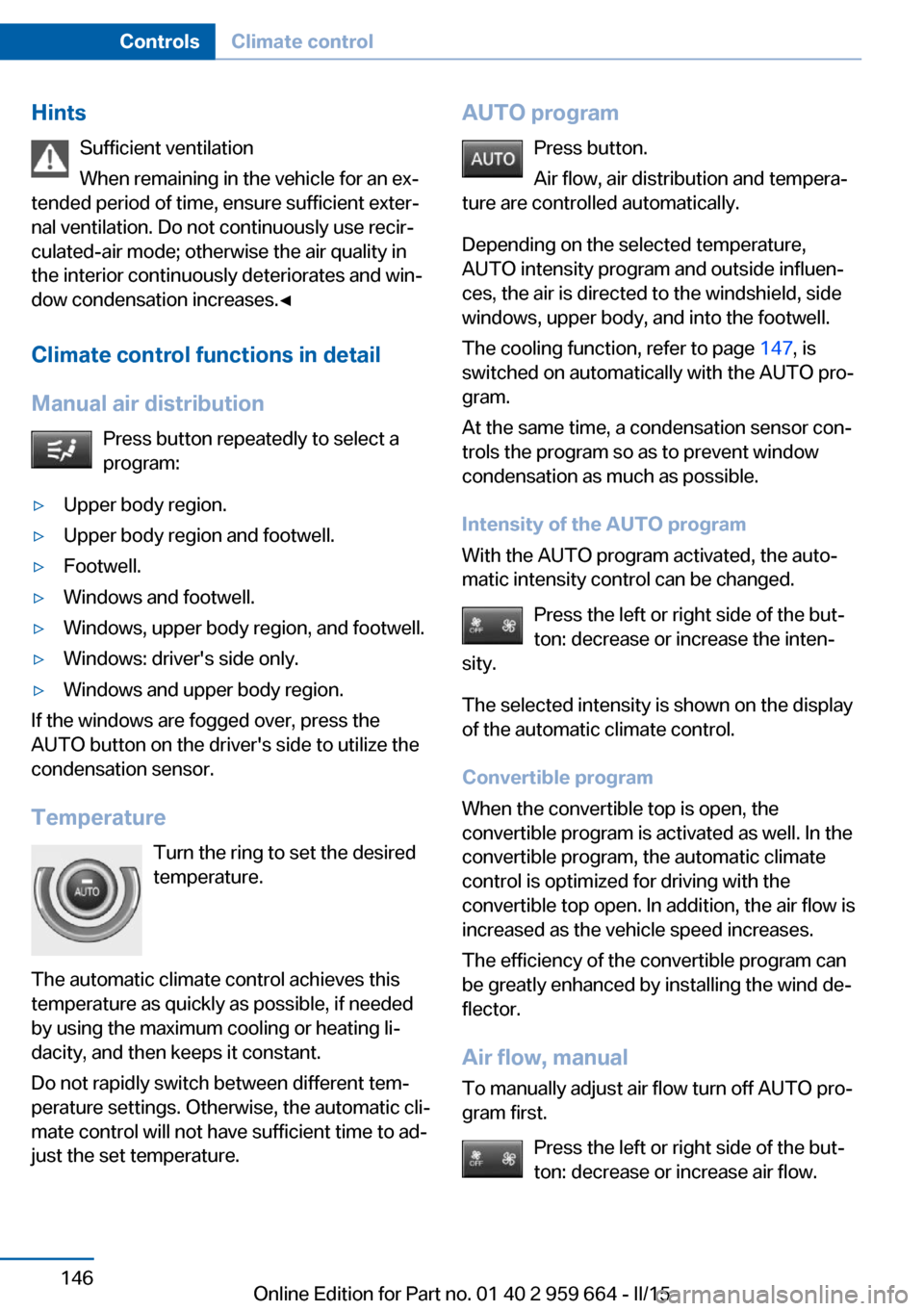
HintsSufficient ventilation
When remaining in the vehicle for an exŌĆÉ
tended period of time, ensure sufficient exterŌĆÉ
nal ventilation. Do not continuously use recirŌĆÉ
culated-air mode; otherwise the air quality in
the interior continuously deteriorates and winŌĆÉ
dow condensation increases.ŌŚĆ
Climate control functions in detail
Manual air distribution Press button repeatedly to select a
program:Ō¢ĘUpper body region.Ō¢ĘUpper body region and footwell.Ō¢ĘFootwell.Ō¢ĘWindows and footwell.Ō¢ĘWindows, upper body region, and footwell.Ō¢ĘWindows: driver's side only.Ō¢ĘWindows and upper body region.
If the windows are fogged over, press the
AUTO button on the driver's side to utilize the
condensation sensor.
Temperature Turn the ring to set the desired
temperature.
The automatic climate control achieves this
temperature as quickly as possible, if needed
by using the maximum cooling or heating liŌĆÉ
dacity, and then keeps it constant.
Do not rapidly switch between different temŌĆÉ
perature settings. Otherwise, the automatic cliŌĆÉ
mate control will not have sufficient time to adŌĆÉ
just the set temperature.
AUTO program
Press button.
Air flow, air distribution and temperaŌĆÉ
ture are controlled automatically.
Depending on the selected temperature,
AUTO intensity program and outside influenŌĆÉ
ces, the air is directed to the windshield, side
windows, upper body, and into the footwell.
The cooling function, refer to page 147, is
switched on automatically with the AUTO proŌĆÉ
gram.
At the same time, a condensation sensor conŌĆÉ
trols the program so as to prevent window
condensation as much as possible.
Intensity of the AUTO program
With the AUTO program activated, the autoŌĆÉ
matic intensity control can be changed.
Press the left or right side of the butŌĆÉ
ton: decrease or increase the intenŌĆÉ
sity.
The selected intensity is shown on the display
of the automatic climate control.
Convertible program
When the convertible top is open, the
convertible program is activated as well. In the
convertible program, the automatic climate
control is optimized for driving with the
convertible top open. In addition, the air flow is increased as the vehicle speed increases.
The efficiency of the convertible program can
be greatly enhanced by installing the wind deŌĆÉ
flector.
Air flow, manual To manually adjust air flow turn off AUTO proŌĆÉ
gram first.
Press the left or right side of the butŌĆÉ
ton: decrease or increase air flow.Seite 146ControlsClimate control146
Online Edition for Part no. 01 40 2 959 664 - II/15